Question
Between 1900 and 2020 the Earth’s average surface air temperature increased by about 1°C.
Temperature affects many biological processes.
(a) Explain how temperature affects enzymes.
(b) Outline the role of the thyroid gland in helping to control body temperature in humans.
(c) Describe how human activities have caused average surface air temperatures on Earth to increase.
Answer/Explanation
Answer:
(a)
a. speed of reaction/catalysis increases as temperature rises;
b. faster molecular motion so more collisions between substrate and active site;
c. denaturation at higher temperatures;
d. (denaturation causes) shape/conformation/structure of enzyme/active site
altered/damaged;
e. an enzyme works fastest at its optimum temperature;
f. inactivation at lower temperatures (due to very few collisions);
g. sketch graph to model the effect of temperature on enzyme activity;
(b)
a. secretes thyroxin;
b. thyroxin causes the metabolic rate to rise;
c. heat released by metabolism;
d. thyroxin increases generation of body heat;
e. thyroxin stimulates shivering/stimulates brown adipose tissue (to release heat);
f. more thyroxin secreted if body temperature too low/converse;
(c)
a. release of carbon dioxide;
b. combustion of fossil fuels produces carbon dioxide;
c. forest fires (caused by humans) produce carbon dioxide;
d. deforestation reduces carbon dioxide uptake by photosynthesis;
e. release of methane;
f. from cattle/sheep/ruminant digestive systems / other verified source of
anthropogenic methane;
g. greenhouse effect / carbon dioxide/methane is a greenhouse gas;
h. carbon dioxide/methane allow short wave radiation in sunlight to pass through
the atmosphere;
i. longer wave/infra-red radiation emitted by the warmed Earth’s surface;
j. carbon dioxide/methane absorbs/reflects back longer wave/infra-red radiation;
Question
Describe the structure and function of starch in plants.
Outline the production of carbohydrates in photosynthesis.
Discuss the processes in the carbon cycle that affect concentrations of carbon dioxide and methane in the atmosphere and the consequences for climate change.
▶️Answer/Explanation
Markscheme
Structure:
a. «starch» is a polysaccharide/is composed of glucose molecules
b. contains amylose which is a linear/helical molecule
c. contains amylopectin which is a branched molecule
Function:
d. storage of glucose/energy in plants
e. storage form that does not draw water
a. light is absorbed by chlorophyll
OR
chlorophyll absorbs more red and blue light
b. «absorbed» light energy is converted to chemical energy
c. some of the energy is used for production of ATP
d. water molecules are split/photolysis
e. produces oxygen «as waste product»/hydrogen/NADPH
f. plants absorb/fix CO2 «from air or water»
g. ATP/energy is needed to produce carbohydrates/starch
a. CO2 is produced from respiration in organisms/combustion of biomass/fossil fuels
b. CH4 is produced by anaerobic respiration of biomass/«methanogenic» bacteria
c. CH4 is oxidized to CO2 and water
d. CO2 is converted into carbohydrates/organic compounds by autotrophs/producers/photosynthesis
e. CO2 can be converted to calcium carbonate/fossilized into limestone
f. «partially» decomposed organic matter/biomass can be converted into peat/coal/oil/gas/fossil fuels
g. CO2 and CH4 are both greenhouse gases/increase greenhouse effect
h. both absorb long-wave radiation from the earth and retain the heat in the atmosphere
i. increased CO2 concentrations in the atmosphere correlate with increased combustion of fossil fuels
j. rising average global temperatures correlate with more greenhouse gases in the atmosphere
k. cattle production/rice paddy/defrosting of tundra increase CH4 in the atmosphere
OR
increasing CO2 leads to acidification of marine/aquatic environments
l. the global temperature increase influences/disrupts climate patterns
OWTTE
Question
The diagram shows the greenhouse effect.
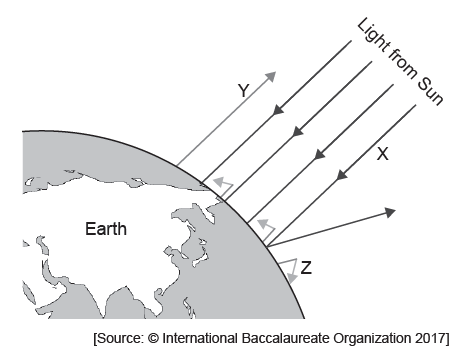
State the type of wavelength of the radiation labelled X and Y.
X:
Y:
Outline reasons for the change occurring at Z.
The short-tailed albatross (Phoebastria albatrus) nests and breeds on remote low-lying coral islands in the Pacific Ocean. Predict how global warming may threaten the survival of such an ocean bird.
▶️Answer/Explanation
Markscheme
X: short-/ultraviolet/UV/visible/EMR/electromagnetic radiation
Y: long-/infrared/IR
a. greenhouse gases present (at Z)
b. greenhouse gases «CO2, methane, nitrous oxide, water vapour» absorb long-wavelengths/infrared
OR
long wavelengths/infrared waves blocked from leaving the atmosphere
c. (long-wavelengths/infrared absorbed and) reradiated/re-emitted (heat Earth)
a. rising ocean levels/more extreme weather «due to global warming» may destroy breeding/nesting sites
OR
rising sea level may put island underwater causing young birds/chicks to drown
b. populations may not find/adapt to new colony sites
c. warming seas may affect the food supply
Question
(i) Distinguish between the thermal properties of water and methane.
(ii) Explain the reasons for the unique thermal properties of water.
Using the diagram, explain the interaction of short and long wave radiation with greenhouse gases in the atmosphere.
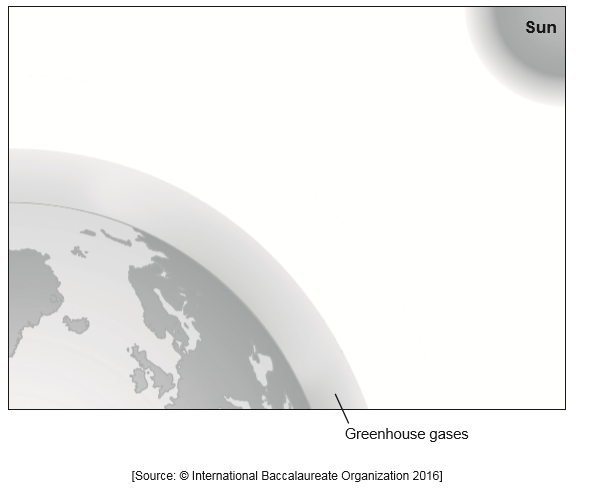
▶️Answer/Explanation
Markscheme
(i)
Boiling point of water is greater than methane
Melting point of water is greater than methane
Latent heat of vaporization of water is greater than methane
OR
specific heat capacity of water is greater than methane
(ii)
Water is polar
OR
O atom more negative
OR
H atoms more positive
This causes «strong» hydrogen bonds to form between the molecules
Which require more/high amount of energy to break
Which increases the melting/boiling/latent heat properties
Short wave radiation/UV «shown as» having its origin in the Sun gives off light as short radiation
Short wave radiation/UV «shown as» passing through the greenhouse gases «some reflected»
Some short wave radiation/UV is absorbed by the Earth and some is reflected
The reflected radiation is long wave radiation «reflected as heat»
Long wave radiation/IR «shown as» being unable to pass through/being absorbed/reflected by the greenhouse gases
Award marks for diagrammatic explanations of these marking points.
Accept UV and IR as long as they are drawn with the correct wavelength.
Question
The biodiversity of insects worldwide is in decline. Destruction of habitats, pollution and climate change have contributed to the decline in global insect populations and to the extinction of insect species. A comprehensive literature review was carried out to determine the annual global rate of decline in insect species. The graph shows the results for three major orders of terrestrial insects and the total decline in insect biomass worldwide.
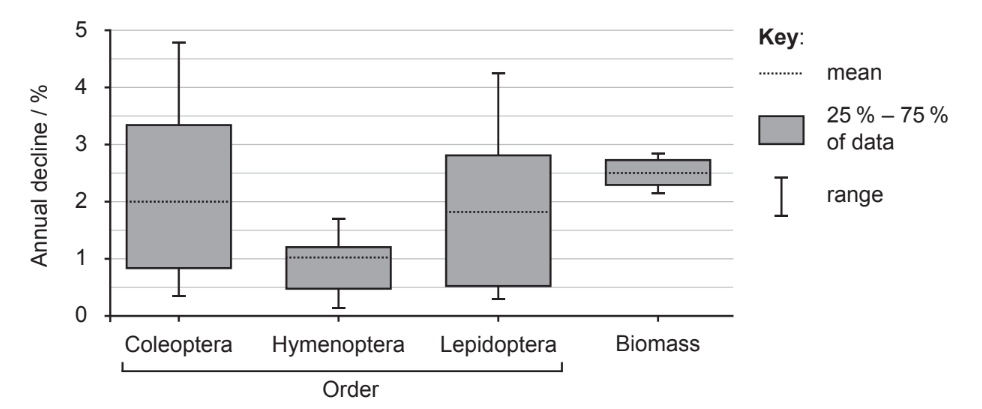
(a) State the mean annual decline in insect biomass.[1]
(b) Compare and contrast the results for Hymenoptera and Lepidoptera.[2]
(c) Calculate the number of Coleoptera species that would be expected to exist after one year from a starting number of 400000 species, assuming the mean rate of decline. [1]
One species of the order Hymenoptera is the buff-tailed bumblebee (Bombus terrestris), which feeds on pollen and nectar obtained from specific plants.
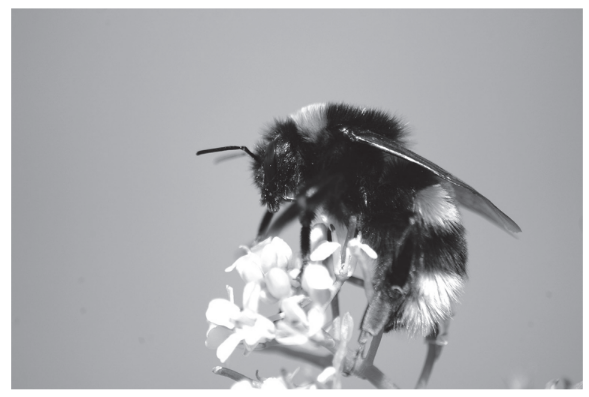
Destruction of preferred habitats has affected the size of bumblebee populations and for survival, bumblebees have to feed on pollen from other available plant habitats. To simulate different pollens, researchers fed bumblebees on eight diets consisting of a mixture of proteins and lipids in different ratios $(P: L)$. The bumblebees also had access to sucrose. There was no restriction on the amount of each food the bumblebees could consume. The chart shows the mean daily mass of food eaten for eight diets with different $P: L$ ratios.
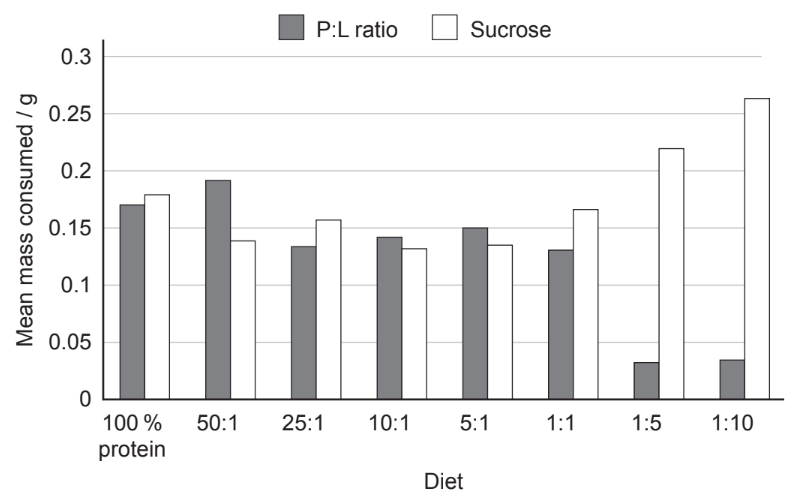
(d) Identify in how many of the diets sucrose was the greatest mass of food consumed. [1]
(e) Compare and contrast the results for the 1:1 and the 1:10 P:L diets. [2]
(f) Calculate the mass of lipid eaten when the bumblebees were presented with the 5:1 diet. [1]
(g) Suggest a reason that the mass of protein and lipid mixture eaten at 25:1 is lower than at 50:1. [1]
The graph shows the percentage of bumblebees that survived each day while being fed on different P:L diets. For each trial, n = 15.
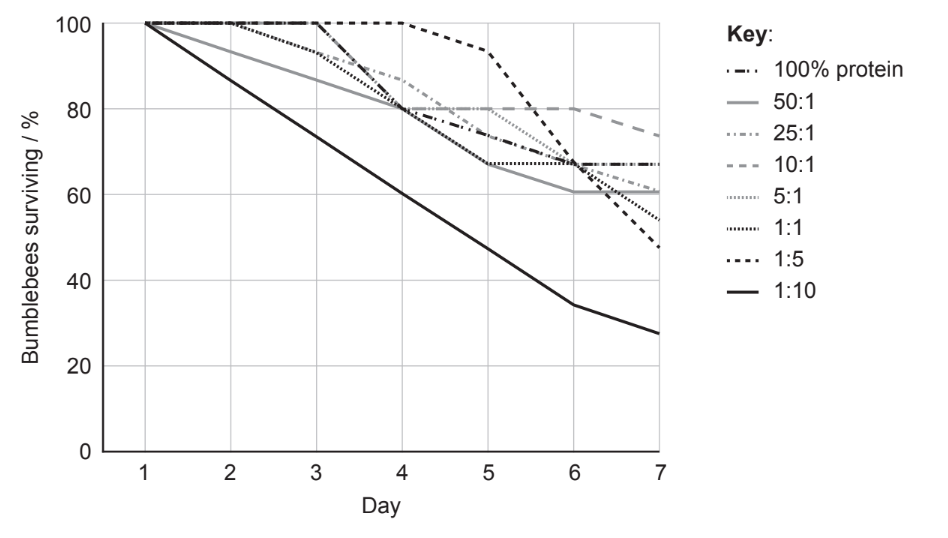
(h) State the relationship between high lipid content and survivability on day 7. [1]
(i) Suggest with a reason which P:L diet is closest to the normal diet of these bumblebees. [1]
(j) Discuss whether these studies show that habitat destruction can affect global bumblebee numbers. [2]
▶️Answer/Explanation
2.5 %; %
b a. both show a decline in number;
b. the mean decline for Hymenoptera is less than the mean for Lepidoptera
OR
there is a wider range of decline among the species of Lepidoptera;
c 392000 (species);
d 5;
e a. in both a greater mass of sucrose was eaten (than of the P:L mixture)
OR
the total mass eaten by both groups is the same/very similar;
b. the mass of sucrose eaten in the 1:10 mixture diet is greater than in the 1:1 diet
OR
the mass of the P:L mixture eaten in the 1:10 is less than in the 1:1;
f 0.025g; Unit needed 1
g a. the mixture was closer to what the bees ate naturally;
b. the bees like the taste better/prefer sucrose;
c. there was more lipid in the 25:1 mixture so they achieved their daily lipid/energy requirement with less mass of food;
d. the bees eating 50:1 diet ate more to reach their daily lipid requirement;
e. prefer the higher proportion of protein (in the 50:1)
h the higher the lipid content, the fewer bees survived/negative correlation;
i 10:1 diet as this has the highest survival rate (after 7 days);
j a. habitat destruction removes the plants/flowers/natural food source of the bees;
b. bees have to look for other food sources;
c. many of these alternative sources of food are not suitable for bee survival
OR
pollen with a different proportion of protein to lipid would reduce survival;
d. no control where bees are fed their normal diet is included;
e. simulation is not using natural pollen / habitat;
OR
sample size is too small to make conclusions;
